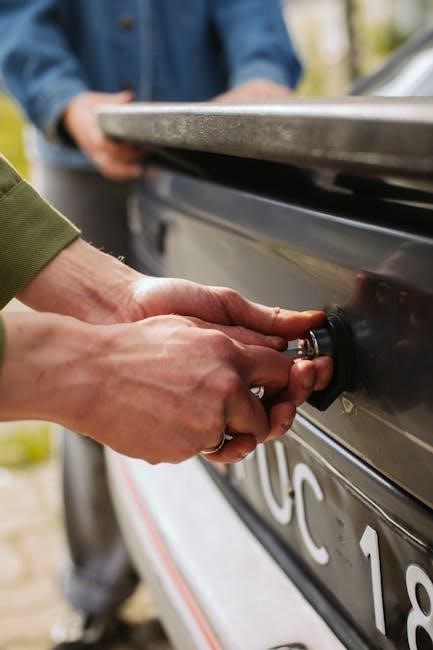GU Patrol manual locking hubs offer enhanced control and durability for off-road enthusiasts. Designed to replace automatic hubs, they provide improved traction and reduce wear on drivetrain components, ensuring reliable performance in challenging terrains.

Benefits of Manual Locking Hubs Over Automatic Hubs
Manual locking hubs for the GU Patrol offer several advantages over automatic hubs, particularly for off-road enthusiasts. They provide increased control, as drivers can manually engage or disengage the hubs, ensuring optimal traction in various conditions. This feature reduces wear on the drivetrain by minimizing unnecessary stress on components when four-wheel drive is not required. Additionally, manual hubs improve fuel efficiency by allowing the vehicle to run in two-wheel drive mode more effectively. They also enhance durability, as they are less prone to mechanical failure compared to automatic hubs. Furthermore, manual hubs are often easier to maintain and repair, making them a cost-effective option in the long run. Overall, manual locking hubs are a reliable and practical upgrade for GU Patrol owners seeking improved performance and reduced maintenance hassles in both on-road and off-road scenarios.

Technical Overview of GU Patrol Manual Locking Hubs
GU Patrol manual locking hubs feature a 31-spline axle shaft design, robust construction, and are engineered for reliability in demanding off-road conditions, ensuring precise control and durability in challenging environments.
How Manual Locking Hubs Work

Manual locking hubs function by enabling drivers to engage or disengage the front wheels from the drivetrain manually. When locked, the hubs connect the axle shafts to the wheels, ensuring power is transferred to both wheels for enhanced traction. This is particularly useful in off-road scenarios where four-wheel drive is necessary. When unlocked, the hubs allow the front wheels to free-spin, reducing wear on the drivetrain and improving fuel efficiency during on-road driving. The process involves setting the hub to the “LOCK” position, which simplifies realignment later. This mechanical control provides drivers with precise management of their vehicle’s traction capabilities, making it ideal for varying driving conditions. The system’s reliability and simplicity contribute to its popularity among off-road enthusiasts seeking durable and efficient performance.
Key Components of the Manual Locking Hub System
The manual locking hub system for the GU Patrol consists of several essential components that work together to provide reliable performance. The primary elements include the locking mechanism, which engages or disengages the hubs, and the bearing assembly, which supports the spindle and allows smooth rotation. The spindle itself connects the hub to the axle, ensuring proper torque distribution. Additionally, the hub housing encases the internal components, protecting them from environmental factors like dust and water. A control mechanism, such as a dial or lever, is used to manually lock or unlock the hubs, offering drivers precise control over the system. These components are designed to withstand the rigors of off-road driving, ensuring durability and longevity. Their seamless integration enables the manual locking hub system to deliver enhanced traction and efficiency in various driving conditions.

Installation Process for Manual Locking Hubs
Installing manual locking hubs on a GU Patrol involves lifting the vehicle, removing the existing hubs, and fitting the new units. Proper alignment and testing are crucial for optimal performance.

Pre-Installation Checks and Preparation
Before installing manual locking hubs on your GU Patrol, ensure the vehicle is lifted safely and wheels are removed. Inspect the axles and suspension for damage or wear. Gather necessary tools and consult the vehicle manual for specific instructions. Verify compatibility of the manual hubs with your Patrol’s make and model. Drain differential fluid if required, and clean the hub area to ensure a smooth installation. Properly align the hubs with the axles before fitting to avoid alignment issues later. Double-check all components for any signs of damage or corrosion. Ensure the locking mechanism is functional and test the hub engagement before finalizing the installation. This preparation ensures a seamless and efficient installation process.
Step-by-Step Installation Guide

Begin by raising the vehicle and removing the wheels. Remove the existing automatic hubs, taking care to mark the axles for proper realignment. Clean the axle splines and surrounding area to ensure a smooth fit. Install the manual locking hubs, aligning them with the marked axles. Tighten the hub nuts in a star pattern to avoid warping the hub. Engage the locking mechanism and test the hub operation. Reinstall the wheels and lower the vehicle. Double-check all connections and test drive the vehicle to ensure proper function. Proper alignment and tightening are crucial for reliable performance. Use a hub wrench for secure tightening, and ensure the hubs are locked before driving. This step-by-step process ensures a safe and effective installation of manual locking hubs on your GU Patrol.

Maintenance and Upkeep of Manual Locking Hubs
Regularly inspect and clean the hubs to prevent dirt buildup. Lubricate moving parts and check for wear. Tighten all bolts and nuts to manufacturer specifications to ensure optimal performance and durability over time. Replace worn components promptly to maintain reliability and prevent damage.
Routine Maintenance Tasks
Routine Maintenance Tasks
Regular maintenance is crucial for the longevity and functionality of manual locking hubs. Start by cleaning the hubs thoroughly to remove dirt and debris, ensuring smooth operation. Inspect the hub locking mechanism for wear or damage, and lubricate all moving parts with a high-quality grease. Check the hub bolts and nuts, tightening them to the manufacturer’s specified torque to prevent loosening while driving. Replace any worn or damaged components promptly to avoid further damage. Additionally, after off-road use, rinse the hubs with clean water to remove mud and contaminants. Regularly applying a rust-inhibiting coating can also protect the hubs from corrosion. By following these routine tasks, you can ensure your manual locking hubs perform reliably, whether on paved roads or challenging off-road terrains.
Common Issues and Solutions
Manual locking hubs on the GU Patrol can occasionally present issues, primarily due to heavy use or harsh conditions. One common problem is a sticking or seized locking mechanism, often caused by dirt or corrosion. To resolve this, clean the hub thoroughly with a wire brush and apply rust-inhibiting lubricant. Another issue is worn or damaged hub splines, which can lead to slippage. Inspect the splines regularly and replace them if necessary. Additionally, over-tightening the hub bolts can damage the threads. Always use a torque wrench to ensure proper tension. If the hubs fail to engage or disengage properly, check for alignment issues or worn internal components. In such cases, replacing the hub assembly may be required. Regular maintenance, such as lubrication and inspection, can prevent many of these issues, ensuring reliable performance both on and off the road.

Troubleshooting Manual Locking Hubs
Troubleshooting manual locking hubs involves identifying common issues like sticking mechanisms or worn components. Regular inspection and proper lubrication are essential. Addressing problems promptly ensures reliable performance and prevents further damage.
Identifying Common Problems
Common issues with manual locking hubs include sticking mechanisms, worn or damaged hub components, and improper engagement. Sticking often results from lack of lubrication or dirt buildup. Worn parts may cause slippage or failure to lock, affecting traction. Improper engagement can lead to disconnection while driving. Regular inspection is crucial to spot these problems early. Lubricating moving parts and cleaning the hub area helps prevent sticking. If components are damaged, replacement is necessary to maintain functionality. Addressing these issues promptly ensures reliable performance and prevents further damage to the drivetrain. By staying vigilant and performing routine checks, owners can keep their manual locking hubs in optimal condition, enhancing both on-road and off-road driving experiences.
DIY Fixes and Repairs
Performing DIY fixes on GU Patrol manual locking hubs can save time and money. Start by cleaning the hub area thoroughly to remove dirt and grime, which can cause sticking. Apply a high-quality lubricant to moving parts to ensure smooth operation. If a hub is sticking, disassemble it and check for worn or damaged components. Replace any faulty parts with genuine or aftermarket alternatives. Proper reassembly is crucial to maintain functionality. For improper engagement issues, adjust the hub mechanism according to the manufacturer’s specifications. Regular lubrication and cleaning can prevent many common problems. By addressing these fixes promptly, owners can ensure their manual locking hubs perform reliably in both on-road and off-road conditions, enhancing vehicle performance and longevity.



